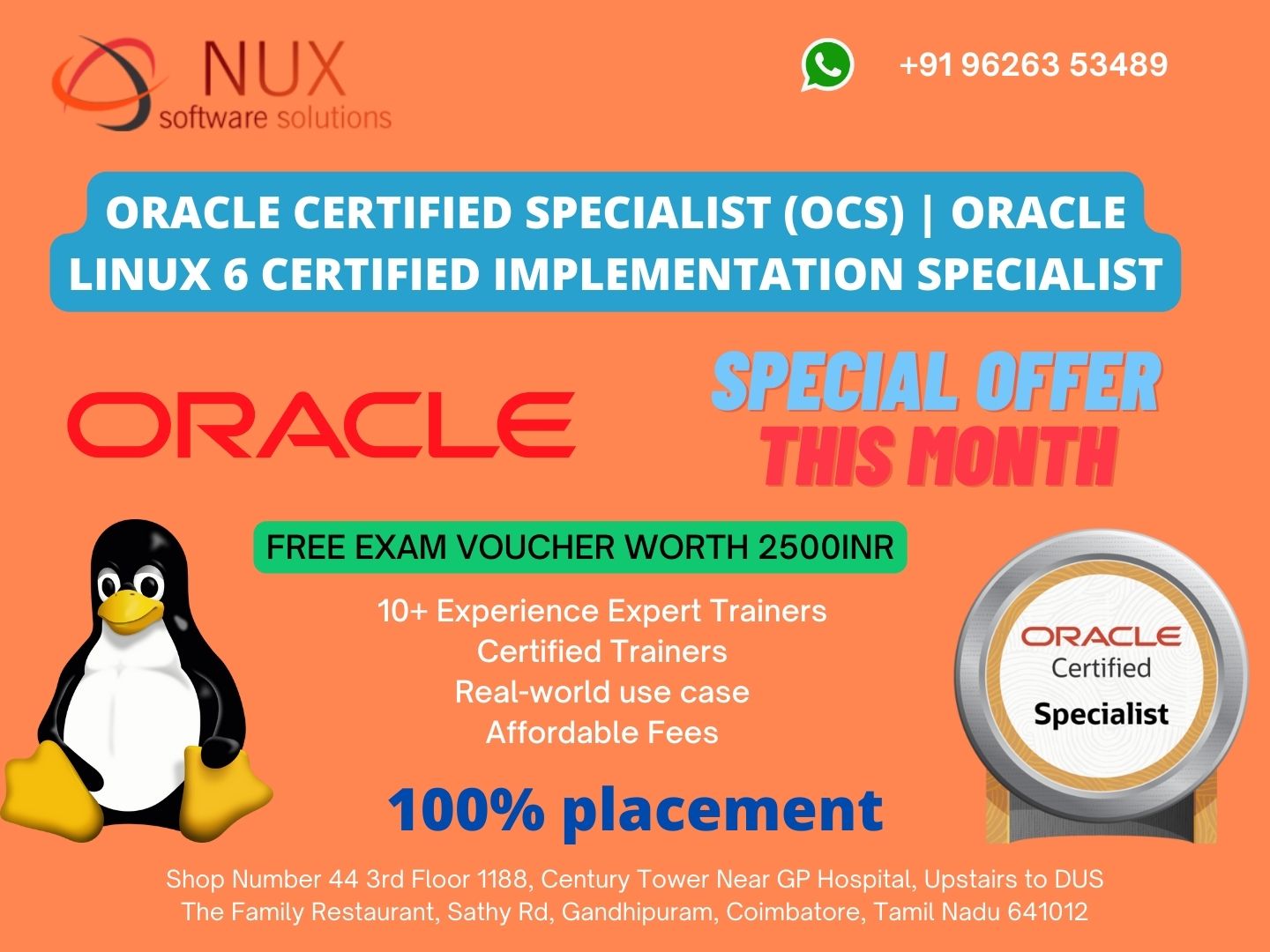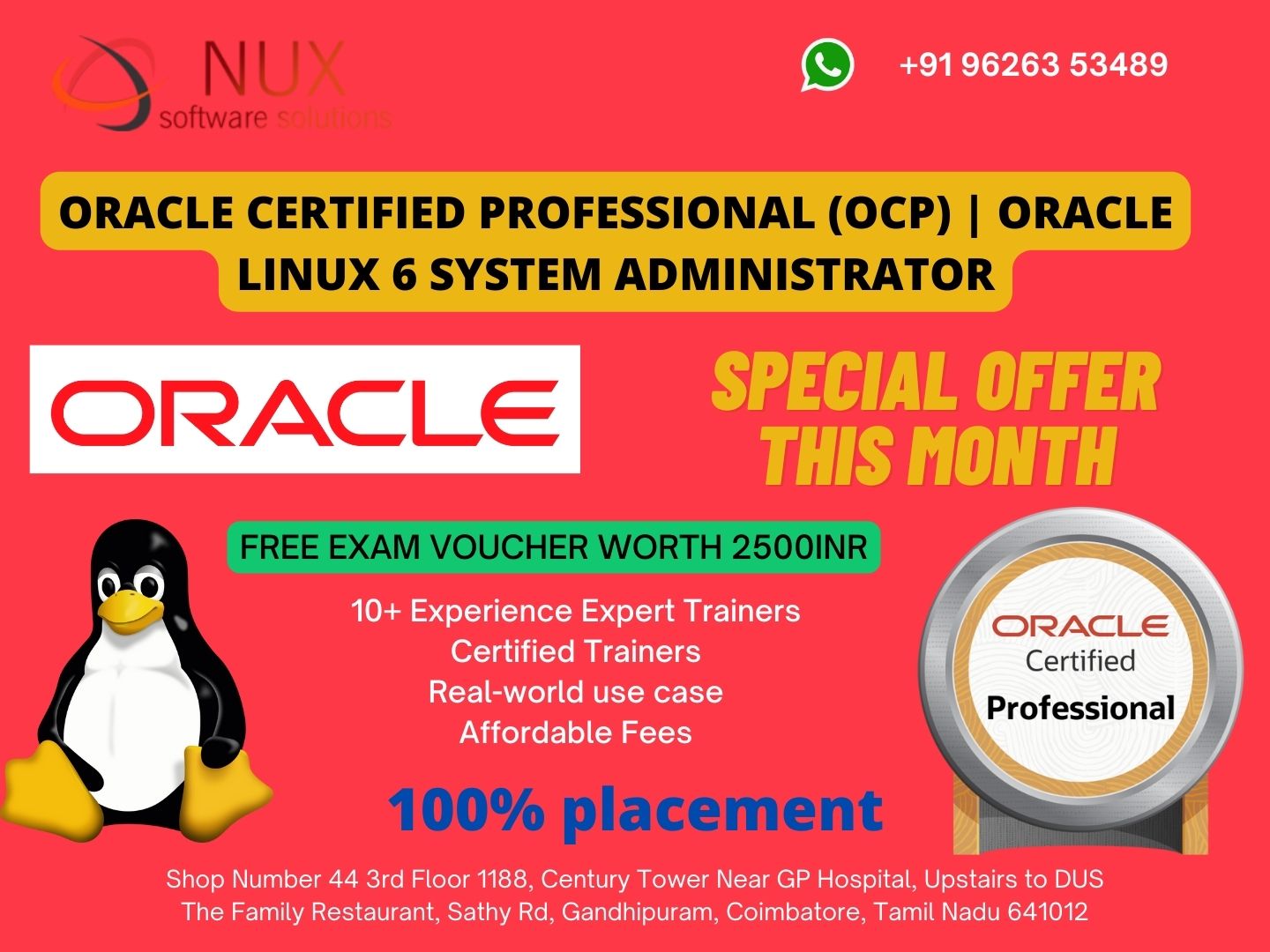LPIC-1: Linux Administrator (101-500 and 102-500)


Nux software Solution is built with the trust of students and emerges out as the best training institute in Coimbatore. It is known for offering the finest LPI (Linux professional Institute) training programs that take out the skills of yours to manage the local storage using logical volumes and partitions. Apart from this, you can also easily control the services, virtual machines, systems, and processes.
LPI (Linux professional Institute) course will give you the capability to install, deploy, configure, update and maintain the Linux systems. In short, our offered Linux training course covers the basic concepts and skill required for proper configuration.
Among others, Nux software Solutions is the best training provider and appreciated for offering advanced training programs that give you better hands-on experience. Our equipped labs are designed to well-support the course and accessible for all the students and professional for 24*7.
Get ready to take the best training under the guidance of industry experts who are updated with the latest innovations. If we trust the figure, since our commencement we have placed more than 10000 students in 500 registered companies. If you are looking for the great salary package and good career exposure, then make your career with Nux software Solutions.
Course Syllabus
Module
Introduction to LPIC-1
1. Introduction2. What are Distros?
3. Windows Xubuntu Setup
4. Windows Rocky Linux Setup
5. Mac Xubuntu Setup
6. Mac Rocky Linux Setup
Configure Hardware Settings
1. Command Line Basics2. Working with Peripherals
3. Proc and Sys Directories
4. The Dev Directory
5. Kernel Modules
Booting the System & Boot Targets
1. The Boot Process2. SysVinit
3. Upstart
4. Systemd
5. Runlevels
6. Boot Targets
Design a Hard Disk Layout
1. MBR vs GPT2. Partitions on a Linux System
3. Filesystem Hierarchy Standard
4. Swapping
5. Mount Points
6. Logical Volume Manager
Boot Managers and Shared Libraries
1. The LILO Boot Loader2. The GRUB Boot Loader
3. The GRUB2 Boot Loader
4. Additional Boot Loaders
5. Shared Libraries
6. Locating Library Files
Package Management for Debian
1. Introduction2. dpkg
3. apt, apt-get & apt-cache
4. aptitude
Red Hat Packages and Virtualization
1. RPM2. YUM
3. Zypper
4. Virtual Machines
5. Containers
6. Infrastructure as a Service
Work on the Command Line
1. Introduction2. Understanding Shells
3. Echo
4. Metacharacters
5. The env Command
6. Variable Scope
7. History and Type
File Management Basics
1. Listing and Changing Directories2. Copying Files
3. Moving Files
4. Changing Timestamps & Querying File Types
Skill: File and Directory Management
1. Creating Directories2. Removing Files and Directories
3. Globbing
4. Finding
5. Creating Archives with Tar
6. Compression
7. Copying Files with dd
Managing Processes
1. Processes and System Information2. Uptime and Memory Statistics
3. Searching Processes with pgrep
4. Jobs
5. Sending Signals to Processes
6. Nohup
7. Multiplexing
8. Managing Process Priorities
Create Partitions and File Systems
1. Block Devices and Partitions2. File Systems
3. Creating Partitions with fdisk
4. Creating File Systems
5. Exploring gdisk and parted
Integrity, Symbolic Links and Hard Links
1. Disk Usage2. Consistency Checking
3. Tuning File System Settings
4. Exploring xfsprogs
5. Hard Links & Soft Links
Mounting File Systems & Searching System Files
1. Mounting and Unmounting2. Persistent Mounting with fstab
3. Mounting with Systemd
4. Locating Files
5. Exploring System Commands
Manage File Permissions & Ownership
1. Owners, Groups & Permissions2. Changing Group Membership & Owners
3. Changing Permissions
4. Special Permissions
5. Default Permissions
Bash Scripting Basics
1. Introduction to Shell Scripting2. Setting and Reading Variables
3. Conditional Logic
4. Loops
5. Sequences and Tests
X11 and Client-Side DNS
1. Introduction to X112. Window and Display Managers
3. Remote Access
4. Wayland
5. Client-Side DNS
Manage Users and Groups
1. User Creation and Deletion2. Creating and Deleting Groups
3. User and Group Modification
4. Working with Passwords
Automate System Administration
1. Introduction to Cron2. Crontab Permissions
3. Understanding Anacron
4. Scheduling One-Time Jobs
5. Scheduling with Systemd
Maintain System Time
1. Introduction to System & Hardware Clocks2. The hwclock command
3. Introduction to NTP
4. NTP Configuration
5. Working with Chronyd
System Logging
1. Introduction to Logging2. Exploring rsyslog
3. Understanding syslog-ng
4. Systemd journaling
5. Using journalctl
Email and Printing
1. Introduction to Linux Email2. Email Configuration
3. Introduction to CUPS
4. Printing Tools
IP Addresses
1. Introduction to IP Addressing2. IPv4 Addressing
3. Public and Private Addresses
4. Subnet Masks
5. IPv6 Addressing
Changing Network Configurations
1. Introduction2. Networking Concepts
3. Network Manager
4. Network Configuration Changes
5. Legacy Configuration Tools
Network Management & Troubleshooting
1. Introduction to Network Troubleshooting2. Testing Connectivity with Ping
3. Tracing Paths
4. Network Connections
System Security
1. Logging User Sessions2. Listing Open Files and Processes
3. Resource Limits and Passwords
4. Superuser Privileges
5. Finding Special Permissions
6. Host and Network Security


